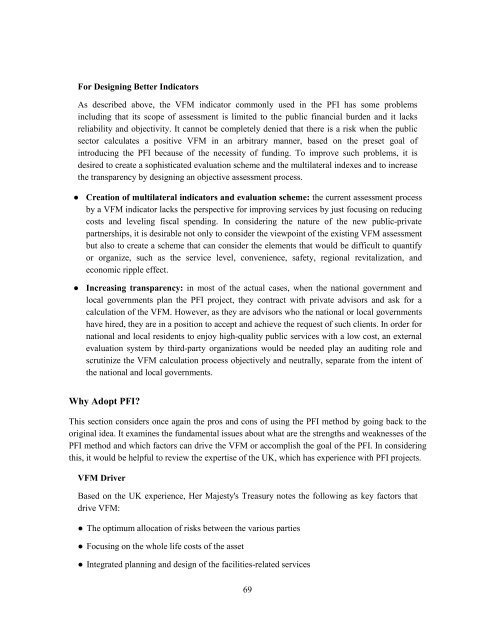Risk Management and Governance for PFI Project ... - Title Page - MIT
Risk Management and Governance for PFI Project ... - Title Page - MIT
Risk Management and Governance for PFI Project ... - Title Page - MIT
You also want an ePaper? Increase the reach of your titles
YUMPU automatically turns print PDFs into web optimized ePapers that Google loves.
For Designing Better Indicators<br />
As described above, the VFM indicator commonly used in the <strong>PFI</strong> has some problems<br />
including that its scope of assessment is limited to the public financial burden <strong>and</strong> it lacks<br />
reliability <strong>and</strong> objectivity. It cannot be completely denied that there is a risk when the public<br />
sector calculates a positive VFM in an arbitrary manner, based on the preset goal of<br />
introducing the <strong>PFI</strong> because of the necessity of funding. To improve such problems, it is<br />
desired to create a sophisticated evaluation scheme <strong>and</strong> the multilateral indexes <strong>and</strong> to increase<br />
the transparency by designing an objective assessment process.<br />
● Creation of multilateral indicators <strong>and</strong> evaluation scheme: the current assessment process<br />
by a VFM indicator lacks the perspective <strong>for</strong> improving services by just focusing on reducing<br />
costs <strong>and</strong> leveling fiscal spending. In considering the nature of the new public-private<br />
partnerships, it is desirable not only to consider the viewpoint of the existing VFM assessment<br />
but also to create a scheme that can consider the elements that would be difficult to quantify<br />
or organize, such as the service level, convenience, safety, regional revitalization, <strong>and</strong><br />
economic ripple effect.<br />
● Increasing transparency: in most of the actual cases, when the national government <strong>and</strong><br />
local governments plan the <strong>PFI</strong> project, they contract with private advisors <strong>and</strong> ask <strong>for</strong> a<br />
calculation of the VFM. However, as they are advisors who the national or local governments<br />
have hired, they are in a position to accept <strong>and</strong> achieve the request of such clients. In order <strong>for</strong><br />
national <strong>and</strong> local residents to enjoy high-quality public services with a low cost, an external<br />
evaluation system by third-party organizations would be needed play an auditing role <strong>and</strong><br />
scrutinize the VFM calculation process objectively <strong>and</strong> neutrally, separate from the intent of<br />
the national <strong>and</strong> local governments.<br />
Why Adopt <strong>PFI</strong>?<br />
This section considers once again the pros <strong>and</strong> cons of using the <strong>PFI</strong> method by going back to the<br />
original idea. It examines the fundamental issues about what are the strengths <strong>and</strong> weaknesses of the<br />
<strong>PFI</strong> method <strong>and</strong> which factors can drive the VFM or accomplish the goal of the <strong>PFI</strong>. In considering<br />
this, it would be helpful to review the expertise of the UK, which has experience with <strong>PFI</strong> projects.<br />
VFM Driver<br />
Based on the UK experience, Her Majesty's Treasury notes the following as key factors that<br />
drive VFM:<br />
● The optimum allocation of risks between the various parties<br />
● Focusing on the whole life costs of the asset<br />
● Integrated planning <strong>and</strong> design of the facilities-related services<br />
69

















